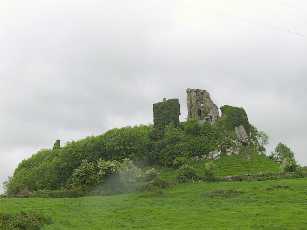|
According to Mainchín Seoighe, the present day parish of Patrickswell-Ballybrown
is made up parts of the pre-Reformation parishes of Kilkeedy, Killonahan,
Mungret, Croom, and Adare. Until the middle of the 18th century, the parishes
of Kilkeedy and Clounanna were joined with Adare. When the parish of Patrickswell
was formed Kilkeedy and Clounanna became part of the new parish. The first
parish priest of the new parish was Fr Nicholas Molony. The present population
of the parish is about 3,400 people.
The village of Patrickswell did not appear on maps until the early years
of the 19th century. However, the name Patrickswell was contained in a
document from 1689 in a list of lands owned by Thomas Rose. Rose was the
owner of a large track of land in the area. Local historian Gerard Beggan
believes that Rose gave Patrickswell its name.

© Carrigogunnell castle
The castle at Carrigogunnell towers over the north of the parish and
is two miles north of the village of Clarina. The Norman William de Burgo
first built a castle here. He had married into the O'Briens, who were
the Kings of Munster. It then became the property of the Earls of Kildare
but was again under the control of the O'Brien's by 1536.
Brien Dhubh O'Brien was regranted the castle in 1584 after he had surrendered
the castle and the Confederates took possession of the castle from 1642
to 1648. It survived many battles until it was blown up in 1691 by the
Williamites to prevent it being ever used again as a fortress for Irish
attacks.
Carrigogunnell is translated into Irish as Carraig Ó gConaing,
which means 'The Rock of the O Conaings'. The O Conaings were the pre-Norman
lords of the area. Alternatively, it can be translated as Carraig
Ó gCoinneall, meaning 'the rock of Uí Choinneall'.
Some people thought that the word coinneal (the Irish for candle)
formed the end of the name Carrigogunnell. Hence the belief that Carrigogunnell
means 'the Rock of the Candle'.
To explain how this name came about, a story was invented. A witch lived
on the rock and each evening she lit a candle on top of the castle. Anyone
who saw this light died immediately. When St Patrick blessed the well
in Patrickswell, he stood on high ground and looked towards Carrigogunnell.
When night fell and the light appeared from the castle, Patrick began
to read from his book. He closed his book and as soon as he did, the light
in the castle was quenched forever.
A couple of hundred feet south-east of Attyflin House, there was a small
mound known as Kyle. Tradition has it that this is the grave of warriors
killed in a battle between the Danes and Brian Boru. Westropp says the
Kyle was 10 feet high and covered with bushes. The exact location of the
Kyle is no longer known. It was destroyed in the 1850s.
According to Lewis, 'a meteoric stone weighing 56 lb fell in the demesne
of Faha' and was in the possession of a Mr. Tuthill. This stone is in
the National Museum of Ireland in Dublin.


|